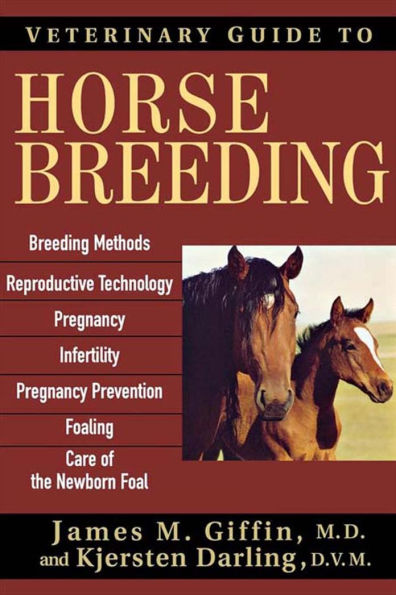Veterinary Guide to Horse Breeding
A landmark breeding resource for new and seasoned horse owners alike
With millions of recreational riders on the bridle paths today, breeding is becoming increasingly popular among horse owners at all experience levels. Whether you are already enjoying the rich rewards of equine breeding or need down-to-earth advice on whether breeding is right for you and your animal, the Veterinary Guide to Horse Breeding offers a thorough, up-to-date overview of the process.
From selecting the best horses to mating, pregnancy, birthing, and caring for a newborn foal, this is the authoritative resource you'll want by your side at all stages of the breeding process to bring healthy, beautiful foals into your life. Features include:
* Guidance on evaluating mares and stallions from bloodline and performance record to overall health and appearance
* Key breeding techniques such as artificial insemination, pasture breeding, and hand breeding
* Pregnancy essentials including testing, gestation, care of pregnant mares, and dealing with complications
* Foaling fundamentals: signs of approaching labor, labor and delivery, care of the postpartum mare, and more
* A complete immunization schedule, physiological evaluation tables and procedures, and a thorough glossary of terms
* More than 100 photos and drawings illustrating anatomy, techniques, and procedures
1102547868
With millions of recreational riders on the bridle paths today, breeding is becoming increasingly popular among horse owners at all experience levels. Whether you are already enjoying the rich rewards of equine breeding or need down-to-earth advice on whether breeding is right for you and your animal, the Veterinary Guide to Horse Breeding offers a thorough, up-to-date overview of the process.
From selecting the best horses to mating, pregnancy, birthing, and caring for a newborn foal, this is the authoritative resource you'll want by your side at all stages of the breeding process to bring healthy, beautiful foals into your life. Features include:
* Guidance on evaluating mares and stallions from bloodline and performance record to overall health and appearance
* Key breeding techniques such as artificial insemination, pasture breeding, and hand breeding
* Pregnancy essentials including testing, gestation, care of pregnant mares, and dealing with complications
* Foaling fundamentals: signs of approaching labor, labor and delivery, care of the postpartum mare, and more
* A complete immunization schedule, physiological evaluation tables and procedures, and a thorough glossary of terms
* More than 100 photos and drawings illustrating anatomy, techniques, and procedures
Veterinary Guide to Horse Breeding
A landmark breeding resource for new and seasoned horse owners alike
With millions of recreational riders on the bridle paths today, breeding is becoming increasingly popular among horse owners at all experience levels. Whether you are already enjoying the rich rewards of equine breeding or need down-to-earth advice on whether breeding is right for you and your animal, the Veterinary Guide to Horse Breeding offers a thorough, up-to-date overview of the process.
From selecting the best horses to mating, pregnancy, birthing, and caring for a newborn foal, this is the authoritative resource you'll want by your side at all stages of the breeding process to bring healthy, beautiful foals into your life. Features include:
* Guidance on evaluating mares and stallions from bloodline and performance record to overall health and appearance
* Key breeding techniques such as artificial insemination, pasture breeding, and hand breeding
* Pregnancy essentials including testing, gestation, care of pregnant mares, and dealing with complications
* Foaling fundamentals: signs of approaching labor, labor and delivery, care of the postpartum mare, and more
* A complete immunization schedule, physiological evaluation tables and procedures, and a thorough glossary of terms
* More than 100 photos and drawings illustrating anatomy, techniques, and procedures
With millions of recreational riders on the bridle paths today, breeding is becoming increasingly popular among horse owners at all experience levels. Whether you are already enjoying the rich rewards of equine breeding or need down-to-earth advice on whether breeding is right for you and your animal, the Veterinary Guide to Horse Breeding offers a thorough, up-to-date overview of the process.
From selecting the best horses to mating, pregnancy, birthing, and caring for a newborn foal, this is the authoritative resource you'll want by your side at all stages of the breeding process to bring healthy, beautiful foals into your life. Features include:
* Guidance on evaluating mares and stallions from bloodline and performance record to overall health and appearance
* Key breeding techniques such as artificial insemination, pasture breeding, and hand breeding
* Pregnancy essentials including testing, gestation, care of pregnant mares, and dealing with complications
* Foaling fundamentals: signs of approaching labor, labor and delivery, care of the postpartum mare, and more
* A complete immunization schedule, physiological evaluation tables and procedures, and a thorough glossary of terms
* More than 100 photos and drawings illustrating anatomy, techniques, and procedures
30.95
In Stock
5
1

Veterinary Guide to Horse Breeding
290
Veterinary Guide to Horse Breeding
290
30.95
In Stock

Product Details
| ISBN-13: | 9781630262488 |
|---|---|
| Publisher: | TURNER PUB CO |
| Publication date: | 07/01/2004 |
| Pages: | 290 |
| Product dimensions: | 6.00(w) x 9.10(h) x 1.00(d) |
